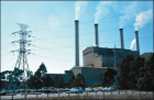A hot debate about the best way to fight over mercury emission is actually taking place in the US.
The background:
Mercury is a global pollutant and reaches even areas remote from any direct emission sources, such as
pristine nature and even the Arctic and Antarctic. Mercury is unlike many other air pollutants; as a neurotoxin, it is more dangerous and more pervasive. Researchers have linked it to learning difficulties and abnormal fetal development in the past. And it is pervasive: scientists have estimated that 8% of American women have mercury levels above those considered safe by the US Environmental Protection Agency.

The main sources of mercury in the environment include coal-fire power stations and chlorine-production plants, as well as gold and silver mines. Coal-burning power plants are responsible for 40 percent of domestic mercury emissions, the U.S. Environmental Protection Agency reports. Power plants spew mercury in two forms (species): elemental mercury and mercury oxides. Elemental mercury can carry for many hundreds of miles. Mercury oxides drop to the ground closer to the emitting plant. When they enter the food chain, both become in part methyl mercury, accumulating in fish and other wildlife.
The most common way people get mercury poisoning is by eating too much poisoned fish. Infants are especially susceptible, methylmercury damaging their central nervous system, leading at least to reduced interlectual capacity, which is why
warnings are more dire for pregnant women.
EPA mercury rule:
Last month (March 21, 2005) EPA announced the
Clean Air Mercury Rule, which is announced to significantly reduce mercury emissions from coal-fired power plants across the US. According to the EPA, the new rules would cut mercury emissions from the nations 600 coal-burning power plants by nearly half within 15 years, from 48 tons of mercury pollution a year down to 24.3 tons in 2020. Taken together, the recently issued
Clean Air Interstate Rule and the new Clean Air Mercury Rule are claimed to reduce electric utility mercury emissions by nearly 70 percent from 1999 levels when fully implemented.
However, the new rules anticipate several years of gradual reductions in mercury pollution that would be a ''co--benefit" of mandates to limit other emissions, such as sulphur dioxide. By 2018, a cap on all mercury emissions would be in place, but power plants with high levels of mercury could continue spewing it by buying emission credits from other plants that exceed reduction targets. This would create mercury hot spots around plants with high emission levels.
The debate:
Environmentalists argue that technology exists now to prevent 90 percent of mercury emissions. If that's the case, why would the EPA create a system for control of mercury emissions that, according to its own Website, would result in a reduction of only 70 percent when fully implemented, sometime after 2018?
In 2000, Bill Clinton's EPA ordered utilities to curb mercury by using the ''maximum achievable control technology." This is called for by the Clean Air Act in the case of hazardous pollutants such as arsenic or lead. Industry, however, has talked Bush's EPA into rescinding the 2000 order. Strict enforcement of ''maximum achievable control technology" would result in reductions three times greater than the EPA rule's cap. The EPA justifies its failure to crack down harder by arguing that much mercury comes from foreign sources. However, it was the Bush administration which opposed an agreement on global mercury restrictions pushed forward by representatives from European countries, who promoted the idea of a treaty to ban the export of mercury completely.
During the UN Environment Programme's Governing Council Meeting, which was held from 21 to 25 February in Nairobi, the United States championed the development of voluntary partnerships to help countries improve their mercury management. The lack of a legally binding pact to regulate this harmful heavy metal has led environment groups to label the UNEP meeting a "missed chance". One expects such complaints from environmentalists, but the environmentalists are hardly alone in this case.
Nine US state attorneys sued the U.S. Environmental Protection Agency this week for adopting a rule that potentially exposes the public to more harmful mercury emissions. Their case will be strengthened by a report in The Washington Post last month that the EPA, in its regulation-making process, ignored a
Harvard study it paid for that showed a much greater health benefit to mercury reductions than the EPA has acknowledged. The
Harvard study that was stripped from public documents by EPA officials estimated health benefits from mercury reductions at 100 times the level used by the EPA. Its disclosure was just the latest evidence that the agency cooked the books to arrive at its weak rule. In the past two months, both the EPA's own inspector general and the Government Accountability Office have faulted the agency's use of scientific evidence in making the mercury rule.
Michael Sperling
 Scientific publications:
Scientific publications:

Leonardo Trasande, Philip J. Landrigan, Clyde Schechter,
Public Health and Economic Consequences of Methylmercury Toxicity to the Developing Brain, Environ. Health. Perspect., 113/5 (2005) 590-596.
DOI: 10.1289/ehp.7743
 Related information:
Related information:
last time updated: October 13, 2024